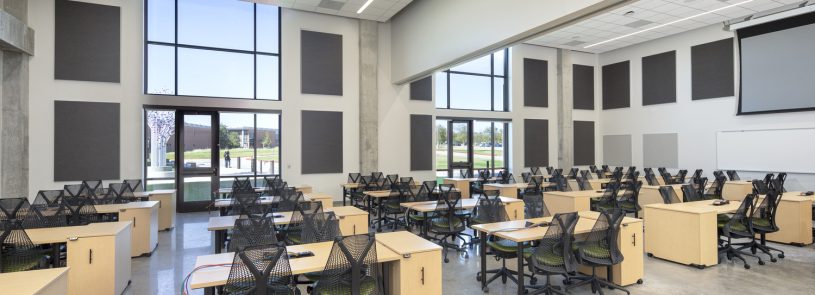4 questions to ask when upgrading classrooms to support flexible learning

By Davin Huston
Stop us if you’ve heard this one:
A professor walks into a classroom. The classroom looks pretty much like the other spaces she uses—a podium, a touch panel, a screen, seating for students. The touch panel has a bunch of custom options, which she must adjust to match the room’s size and capabilities to accommodate this particular class.
But the interface isn’t standardized across campus. The professor, who works in different classrooms in different spaces, must remember today’s interface and set the options for this room. She and all the other professors end up spending valuable classroom time frustrated by the technology and after they finally get it set up, they are distracted and exhausted. Not the best frame of mind to deliver that day’s content.
Or this one:
Students enter a classroom. Many walked in and took their seats. Some who usually attend in person are home sick and accessing a video conferencing system they rarely use. Several others are distance learning students, remote in every session.
For the next 90 minutes of the class, remote-access students struggle to participate and compete against the 80 students who are breathing the same air as the professor. The building’s ancient HVAC vents are right above the room’s microphone and the sound of air conditioning cycling on and off muffles the professor’s voice.
They watch a video before splitting up to do group work. The remote students don’t have a studio-quality microphone on their computers, so their sound quality is diminished. Between that and the sound of the HVAC they barely comprehend the video, then have trouble getting their group’s attention to participate in the break-out discussion. They struggle to stay focused, start questioning what they are learning, and begin wondering why they are paying all that tuition for this experience.
Sound familiar? It should. Hybrid and HyFlex classrooms—where students decide if they’ll attend in person, through videoconference, or by watching a recording later—are major sources of inequity across colleges and universities every day.
It doesn’t have to be that way. By engaging a technology design professional early on in a renovation or new build, a university can vastly improve hybrid and HyFlex design. In addition to determining the size and number of rooms needed, how many students the rooms will serve, and if the spaces will be teaming environments, a professional should also ask or discuss:
- How to allow remote students to be in the forefront or work alongside the in-person students and other remote students.
- The campus’s video conferencing solution(s)—e.g., Microsoft Teams, Zoom, Cisco, Webex, etc.
- Whether the user interface is standardized across campus. If it is not, can it be standardized according to type of classrooms, like general lecture halls or laboratories?
- Who maintains the technology within the spaces. General purpose classrooms are often designed and managed by the IT and Learning Technologies departments, while the audio-visual technology needs for specialized spaces, like labs, are driven by the academic department and Learning Technologies. This can lead to conflicting technologies, or technologies the IT department cannot maintain or service.
Good technology design can reduce frustration and improve the faculty and student experience. In addition to improving end-user experience, having the technology designed and the systems in place from day one will save time and money later, when it will cost more to accommodate the equipment after the fact.
Davin Huston is an IMEG Technology Designer of Distinction.











